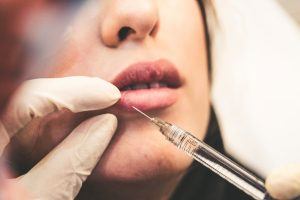Blood or Body Fluid (BBF) Exposure
Healthcare providers are at higher risk of exposure to infectious agents due to their work environments. Exposure to blood and body fluids can occur during client care or in the healthcare environment. Being up to date on vaccinations, performing point-of-care risk assessments, following infection prevention and control best practices, and handling sharps safely according to agency policies will decrease your risk of exposure to infections.
A blood and body fluid (BBF) exposure is defined as an exposure to potentially infectious body fluids or blood through the following methods:
- Percutaneous exposure — a puncture wound by a sharp object or needle.
- Permucosal exposure — from body fluids or blood that splashes onto your mucous membranes.
- Non-intact skin exposure — through eczema, an open wound, lesion, or scratch (BC Centre for Disease Control, [BCCDC], 2017).
Prior to providing care, you need to perform a risk assessment. If you know you will be potentially exposed to body fluids (e.g., assisting a client with elimination, inserting a catheter, assisting feeding newborns breastmilk) or blood (e.g., changing a dressing, starting an IV), then you must determine what PPE you will need based on your assessment to ensure your safety and decrease the risk of transmission. For example: using clean gloves when handling all blood and body fluids, wearing a gown if blood or body fluids may touch your uniform or exposed skin, wearing a face shield if splashing of body fluids will occur, and following additional precautions as required. Improper PPE use has been linked to the transmission of microorganisms. Handle all blood, body fluids, and laboratory specimens as if infectious.

If exposure does occur, you need to adhere to agency policies and report the incident to your supervisor or manager, occupational health, and IPAC team. A thorough assessment is required to determine immediate actions, prophylaxis care, and follow-up, including prevention education. Review Chapter 7: Clinical Tip on Needle and Sharp Safety to learn how to decrease your risk of a needle or sharp injury.
Post-exposure management is required when:
- Percutaneous, permucosal, or non-intact skin is exposed to a BBF.
- The exposure is to blood or potentially infectious body tissue or fluid.
- The source is considered potentially infectious. For example, if the client is part of a high-risk group, exposure occurred in a high-risk setting, or the client has tested positive for an infectious agent.
- The exposed person is considered susceptible to HIV, hepatitis B, or hepatitis C.
First aid should be performed immediately, and the incident should be reported. The risks and benefits of the post-exposure immunoprophylaxis should be discussed and appropriate recommendations made to the exposed person.
Post-exposure could also have psychological and emotional implications. Even if the event has a relatively low risk of infection from an exposure, it can be associated with stress and anxiety for the exposed person. Counselling and education regarding the incident and future prevention should be discussed.
The following checklist (BCCDC, 2017; PIDAC, 2012) explains what to do if you are exposed to BBF. Always review and follow your healthcare setting policies regarding specific requirements.
What to Do when Exposed to Blood and Body Fluids
Point of Consideration: Post-Exposure Prophylaxis (PEP)
Any type of blood or body fluid exposure for a healthcare provider can be a worrisome experience. If a healthcare provider has been exposed to HIV, for example from a needle stick injury, there are antiretroviral medications the individual can take. Post-exposure prophylaxis (PEP) are antiretroviral medication that should be taken immediately or within 72 hours of the exposure to help prevent the transmission of HIV. The medication needs to be taken every day for 28 days to decrease the risk of transmission. To learn more about PEP click on the link: CATIE.
Canada’s source for HIV and hepatitis C information. (2019). Post-exposure prophylaxis (PEP). https://www.catie.ca/fact-sheets/prevention/post-exposure-prophylaxis-pep
Test your Knowledge
Attribution
This page was remixed with our own original content and adapted from:
Clinical Procedures for Safer Patient Care — Thompson Rivers University Edition by Renée Anderson, Glynda Rees Doyle, and Jodie Anita McCutcheon is used under a CC BY 4.0 Licence. This book is an adaptation of Clinical Procedures of Safer Patient Care by Glynda Rees Doyle and Jodie Anita McCutcheon, which is under a CC BY 4.0 Licence. A full list of changes and additions made by Renée Anderson can be found in the About the Book section.

